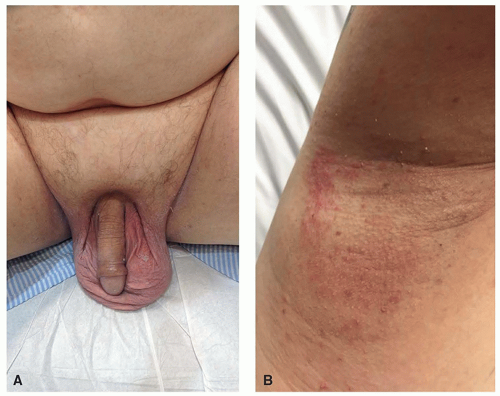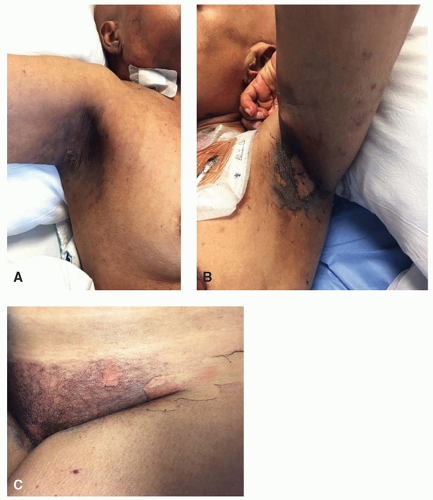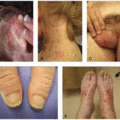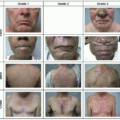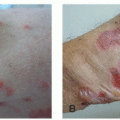Intertriginous Reactions
Rachel Reingold
Alina Markova
An intertriginous reaction pattern may present as erythematous, desquamative, scaly, dusky or eroded patches or plaques commonly affecting one or more folds in the axillary, inguinal, genital, gluteal, or perianal regions. The most common diagnoses presenting with an intertriginous reaction pattern to anticancer therapies are discussed below.
TOXIC ERYTHEMA OF CHEMOTHERAPY1
Toxic erythema of chemotherapy (TEC) encompasses a spectrum of overlapping toxic reactions (eg, neutrophilic eccrine hidradenitis, hand foot syndrome, eccrine syringometaplasia) in the skin and mucosa presenting 1 to 3 weeks after cytotoxic chemotherapy. TEC commonly affects the intertriginous regions, hands, feet, vulva, and scrotum, but can also involve the knees, elbows, and ears. Presentation includes erythematous or dusky patches or plaques, which may have secondary changes including edema, scaling, crusting, bullae, and erosions, often associated with pain, itching, and/or burning (Figure 7.1). Lesions often spontaneously heal leaving desquamated and hyperpigmented skin but can recur with re-exposure at equal or increased doses of culprit chemotherapy. In patients with darker skin tones, early erythematous patches may be subtle and difficult to appreciate, leading to a delayed diagnosis (Figure 7.2). Suspected pathophysiology is from exposure to high concentrations of chemotherapy in the intradermal
and intraepidermal eccrine ducts causing local cellular toxicity. Intertriginous areas where sweat is occluded and sites of high eccrine density are preferentially involved.
and intraepidermal eccrine ducts causing local cellular toxicity. Intertriginous areas where sweat is occluded and sites of high eccrine density are preferentially involved.
ANTICANCER THERAPY CLASS
Alkylating agents
Antimetabolites
Anthracyclines
Antitumor antibiotics
Microtubule inhibitors
Topoisomerase inhibitors
ANTICANCER AGENTS
Cytarabine*
Anthracyclines*
5-Fluorouracil*
Capecitabine*
Stay updated, free articles. Join our Telegram channel

Full access? Get Clinical Tree



